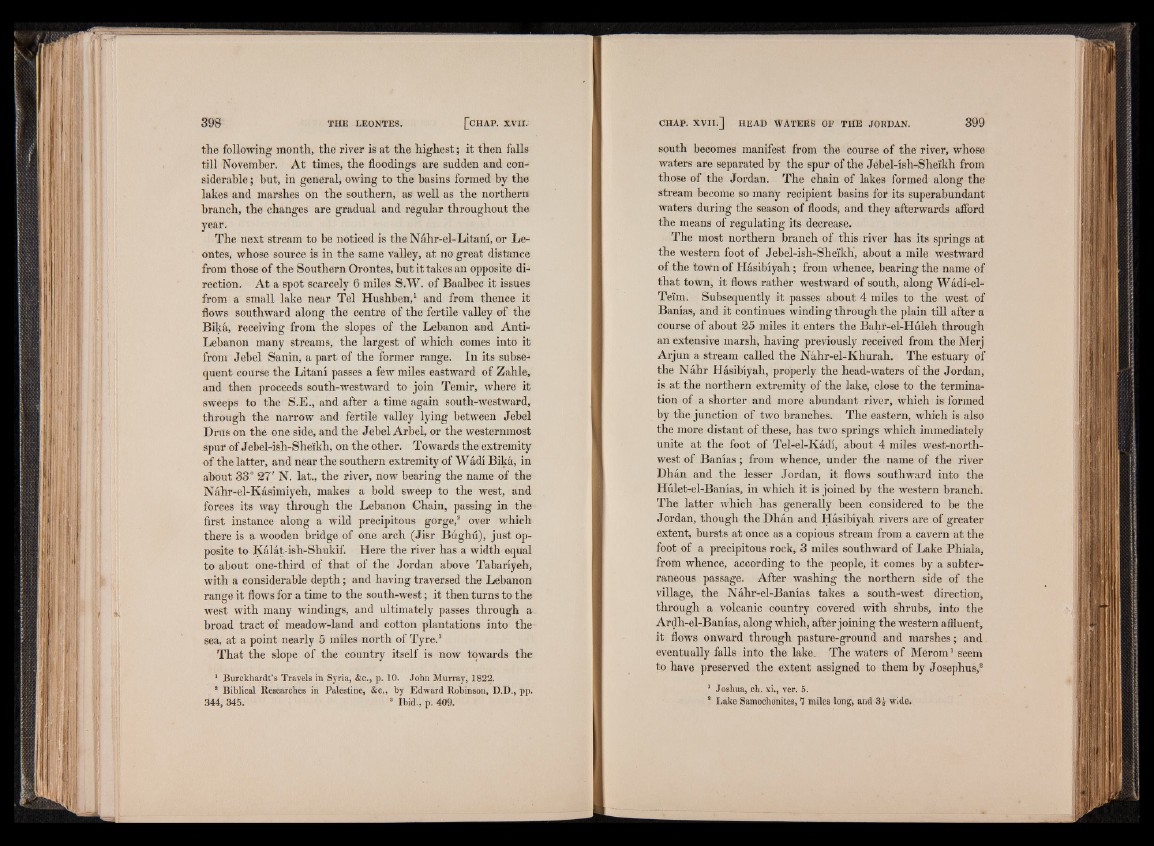
the following month, the river is at the highest; it then falls
till November. At times, the floodings are sudden and considerable
; but, in general, owing to the basins formed by the
lakes and marshes on the southern, as well as the northern
branch, the changes are gradual and regular throughout the
year.
The next stream to be noticed is the N&hr-el-Litani, or Le-
ontes, whose source is in the same valley, at no great distance
from those of the Southern Orontes, but it takes an opposite direction.
At a spot scarcely 6 miles S.W. of Baalbec it issues
from a small lake near Tel Hushben,1 and from thence it
flows southward along the centre of the fertile valley of the
Bika, receiving from the slopes of the Lebanon and Anti-
Lebanon many streams, the largest of which comes into it
from Jebel Sanin, a part of the former range. In its subsequent
course the Litani passes a few miles eastward of Zahle,
and then proceeds south-westward to join Temir, where it
sweeps to the S.E., and after a time again south-westward,
through the narrow and fertile valley lying between Jebel
Drus on the one side, and the Jebel Arbel, or the westernmost
spur of Jebel-ish-She'ikh, on the other, Towards the extremity
of the latter, and near the southern extremity of Wadi Bika, in
about 33° 27' N. lat., the river, now bearing the name of the
Nahr-el-Kasimiyeh, makes a bold sweep to the west, and
forces its way through the Lebanon Chain, passing in the
first instance along a wild precipitous gorge,2 over which
there is a wooden bridge of one arch (Jisr Bughu), just opposite
to Kalat-ish-Shukif. Here the river has a width equal
to about one-third of that of the Jordan above Tabariyeh,
with a considerable depth; and having traversed the Lebanon
range it flows for a time to the south-west; it then turns to the
west with many windings, and ultimately passes through a
broad tract of meadow-land and cotton plantations into the
sea, at a point nearly 5 miles north of Tyre.3
That the slope of the country itself is now towards the
1 Burckhardt’s Travels in Syria, &c., p. 10. John Murray, 1822.
* Biblical Researches in Palestine, &c., by Edward Robinson, D.D., pp.
344, 345. 8 Ibid., p. 409.
south becomes manifest from the course of the river, whose
waters are separated by the spur of the Jebel-ish-Shei'kh from
those of the Jordan. The chain of lakes formed along the
stream become so many recipient basins for its superabundant
waters during the season of floods, and they afterwards afford
the means of regulating its decrease.
The most northern branch of this river has its springs at
the western foot of Jebel-ish-She'ikh', about a mile westward
of the toWn of Hasibiyah; from whence, bearing the name of
that town, it flows rather westward of south, along Wadi-el-
Tei'm, Subsequently it passes about 4 miles to the west of
Banias, and it continues winding through the plain till after a
course of about 25 miles it enters the Bahr-el-Huleh through
an extensive marsh, having previously received from the Merj
Arjun a Stream called the Nahr-el-Khurah. The estuary of
the Nahr Hasibiyah, properly the head-waters of the Jordan,
is at the northern extremity of the lake, close to the termination
of a shorter and more abundant river, which is formed
by the junction of two branches. The eastern, which is also
the more distant of these, has two springs which immediately
unite at the foot of Tel-el-Kadi, about 4 miles west-north-
west of Banias; from whence, under the name of the river
Dhan and the lesser Jordan, it flows southward into the
Hulet-el-Banias, in which it is joined by the western branch.
The latter which has generally been considered to be the
Jordan, though the Dhan and Hasibiyah rivers are of greater
extent, bursts at once as a copious stream from a cavern at the
foot of a precipitous rock, 3 miles southward of Lake Phiala,
from whence, according to the people, it comes by a subterraneous
passage. After washing the northern side of the
village, the Nahr-el-Banias takes a south-west direction,
through a volcanic country covered with shrubs, into the
Ardh-el-Banias, along which, after joining the western affluent,
it flows onward through pasture-ground and marshes; and.
eventually falls into the lake. The waters of Merom1 seem
to have preserved the extent assigned to them by Josephus,®
1 Joshua, ch. xi,, ver. 5.
8 Lake Samoohonites, 1 miles long, and 3* wide.